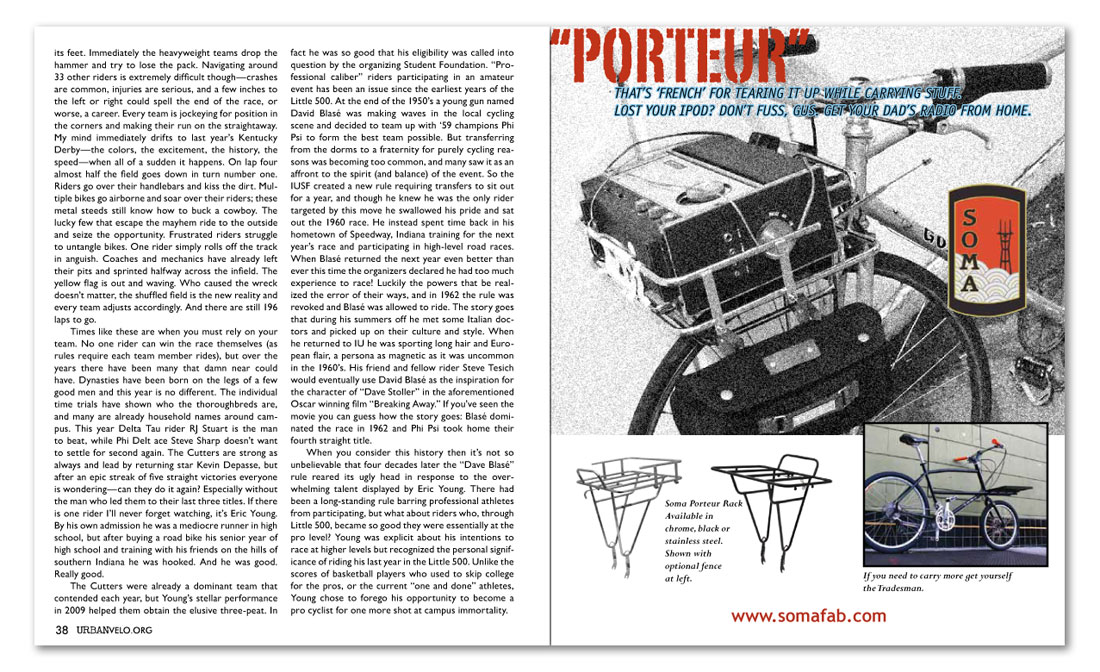


its feet. Immediately the heavyweight teams drop the hammer and try to lose the pack. Navigating around 33 other riders is extremely difficult though—crashes are common, injuries are serious, and a few inches to the left or right could spell the end of the race, or worse, a career. Every team is jockeying for position in the corners and making their run on the straightaway. My mind immediately drifts to last year’s Kentucky Derby—the colors, the excitement, the history, the speed—when all of a sudden it happens. On lap four almost half the field goes down in turn number one. Riders go over their handlebars and kiss the dirt. Multiple bikes go airborne and soar over their riders; these metal steeds still know how to buck a cowboy. The lucky few that escape the mayhem ride to the outside and seize the opportunity. Frustrated riders struggle to untangle bikes. One rider simply rolls off the track in anguish. Coaches and mechanics have already left their pits and sprinted halfway across the infield. The yellow flag is out and waving. Who caused the wreck doesn’t matter, the shuffled field is the new reality and every team adjusts accordingly. And there are still 196 laps to go.
Times like these are when you must rely on your team. No one rider can win the race themselves (as rules require each team member rides), but over the years there have been many that damn near could have. Dynasties have been born on the legs of a few good men and this year is no different. The individual time trials have shown who the thoroughbreds are, and many are already household names around campus. This year Delta Tau rider RJ Stuart is the man to beat, while Phi Delt ace Steve Sharp doesn’t want to settle for second again. The Cutters are strong as always and lead by returning star Kevin Depasse, but after an epic streak of five straight victories everyone is wondering—can they do it again? Especially without the man who led them to their last three titles. If there is one rider I’ll never forget watching, it’s Eric Young. By his own admission he was a mediocre runner in high school, but after buying a road bike his senior year of high school and training with his friends on the hills of southern Indiana he was hooked. And he was good. Really good.
The Cutters were already a dominant team that contended each year, but Young’s stellar performance in 2009 helped them obtain the elusive three-peat. In fact he was so good that his eligibility was called into question by the organizing Student Foundation. “Professional caliber” riders participating in an amateur event has been an issue since the earliest years of the Little 500. At the end of the 1950’s a young gun named David Blasé was making waves in the local cycling scene and decided to team up with ‘59 champions Phi Psi to form the best team possible. But transferring from the dorms to a fraternity for purely cycling reasons was becoming too common, and many saw it as an affront to the spirit (and balance) of the event. So the IUSF created a new rule requiring transfers to sit out for a year, and though he knew he was the only rider targeted by this move he swallowed his pride and sat out the 1960 race. He instead spent time back in his hometown of Speedway, Indiana training for the next year’s race and participating in high-level road races. When Blasé returned the next year even better than ever this time the organizers declared he had too much experience to race! Luckily the powers that be realized the error of their ways, and in 1962 the rule was revoked and Blasé was allowed to ride. The story goes that during his summers off he met some Italian doctors and picked up on their culture and style. When he returned to IU he was sporting long hair and European flair, a persona as magnetic as it was uncommon in the 1960’s. His friend and fellow rider Steve Tesich would eventually use David Blasé as the inspiration for the character of “Dave Stoller” in the aforementioned Oscar winning film “Breaking Away.” If you’ve seen the movie you can guess how the story goes: Blasé dominated the race in 1962 and Phi Psi took home their fourth straight title.
When you consider this history then it’s not so unbelievable that four decades later the “Dave Blasé” rule reared its ugly head in response to the overwhelming talent displayed by Eric Young. There had been a long-standing rule barring professional athletes from participating, but what about riders who, through Little 500, became so good they were essentially at the pro level? Young was explicit about his intentions to race at higher levels but recognized the personal significance of riding his last year in the Little 500. Unlike the scores of basketball players who used to skip college for the pros, or the current “one and done” athletes, Young chose to forego his opportunity to become a pro cyclist for one more shot at campus immortality.